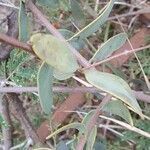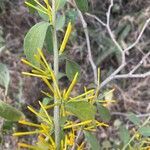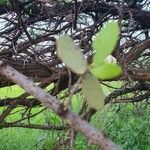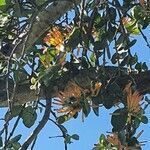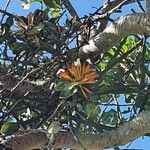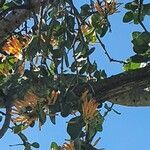Leaves heteromorphic, those on long shoots always sessile (except sometimes 1–2 basal pairs) and generally more markedly sagittate or cordate at base, those on short shoots with a petiole up to 1(3 inland) mm long; lamina 0.8–4.5(6) × 0.5–3 cm, diversely lanceolate to obovate or circular, rounded to cordate or sagittate at base, 3–7-nerved, with venation conspicuous to obscure.
Petals separate, 3–3.5 cm long, normally ageing from yellow-green through yellow and orange to red, but inland often yellow and sometimes with a redder basal part; basal part slightly S-shaped, 6–8 mm long, with 4–7 paired folds inside; distal part recurving, twisted, linear-spathulate above.
Umbels normally terminal on leafy short shoots, atypically 1–several at leafy or leafless nodes, 3–7(12)-flowered; peduncle 5–10(17) mm long; pedicels 6–10 mm long.
Stamens orange, pink or red; anthers 7–9 mm long.
Berry red, 9–10 × 7 mm, ellipsoid, smooth.
Receptacle 2.5–4 mm long, campanulate.
Calyx 0.5–1 mm long, rim-like.
